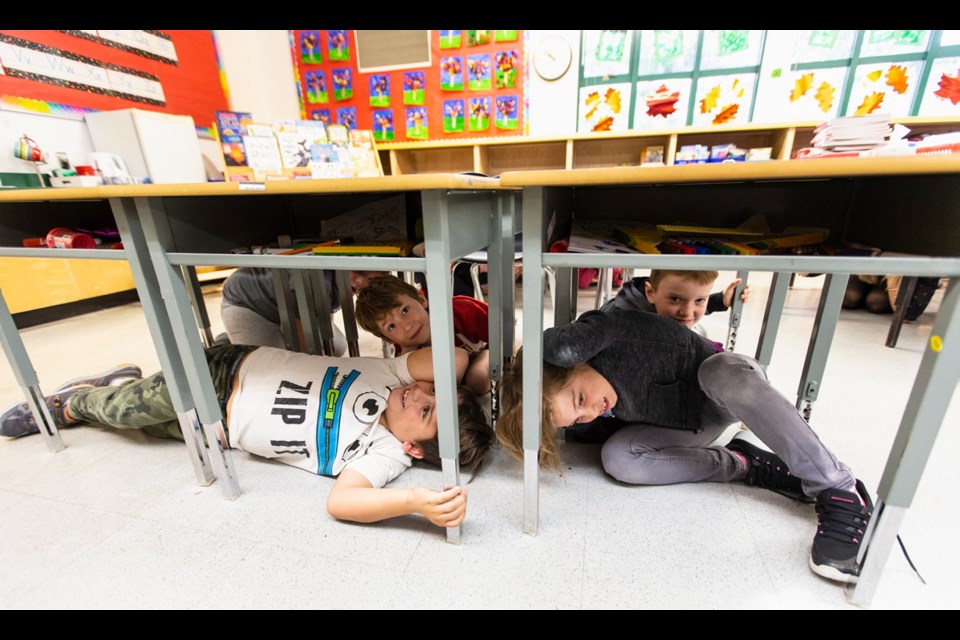Victoria councillors were set to stop their committee meeting at 10:17 a.m. today and crawl under their desks to take part in the Great B.C. ShakeOut earthquake drill.
“Studies have shown that it is the best thing to do to reduce injuries and death during an earthquake because of flying objects or falling debris,” said Tanya Patterson, Victoria’s emergency-management co-ordinator.
“Obviously, our instant reaction is to run out of a building or to run to get your children or loved ones.”
Standing in a doorway has been debunked as a safe place when an earthquake hits, she said. Doorways don’t provide any extra structural stability, so they’re no safer a location than against an inside wall. “The added hazard of standing in a doorway is that the door may slam shut on your hand.”
The Victoria council chamber drill was expected to be among thousands of such drills around the province today, including at workplaces, schools, health-care institutions, government facilities and private homes.
City of Victoria staff — about 1,000 people — are all being encouraged to take part in the drill, Patterson said.
“We’re hoping that everybody will participate.”
Personnel at all three city fire halls are taking part, while park and public-works staff have been advised about what to do if they are in a vehicle or out in the open. That includes pulling over as soon as possible, away from hazards such as power lines if you’re driving, and curling up and covering your head if you’re outside.
B.C.’s ShakeOut is part of an international earthquake-preparedness effort that will involve millions of people. The time of the exercise corresponds with the date, 10/17.
Patterson said the annual ShakeOut serves a useful purpose, especially in promoting the steps that should be taken to help protect yourself — dropping to the floor, taking cover under a desk or other piece of furniture and holding onto the furniture until the shaking stops.
It’s summarized in the slogan: drop, cover, hold on.
Audio and video to help with the drill can be downloaded from shakeoutbc.ca, and will be played at the Victoria council committee meeting. Anyone attending the meeting will be asked to join in.
ShakeOut drills are popular at schools.
“I know my kids are in School District 61 and they participate in these drills, not just on ShakeOut but all throughout the year,” Patterson said.
“They play audio over the PA system and they start expanding the drill to include evacuation and school-reunification drills and all the aftermath that might happen.”
Saanich School District superintendent Dave Eberwein said notices have been sent to all schools reminding them that the ShakeOut is happening.
“I anticipate most, if not all, schools will be doing something,” he said. “It gives that heightened awareness, that preparedness.”
How to protect yourself in an earthquake
An earthquake could suddenly intensify. To protect yourself, immediately drop, cover and hold on.
Drop to hands and knees.
Seek cover by crawling under a nearby table or desk. If one isn’t available, crawl to an interior wall away from windows. Stay on knees and bend over to protect vital organs.
Hold on. If under a table or desk, hold onto it with one hand and be ready to move with it if it moves. If you’re not under shelter, hold onto your head and neck with arms and hands.
During the quake, don’t move. The motion can become so violent that you won’t be able to run or crawl.
In bed: stay in bed, lie face down to protect vital organs, cover head and neck with pillow, keep arms as close to head as possible.
In a wheelchair: lock wheels, stay seated, protect head and neck with arms, pillow, book or whatever is available
In a stadium or theatre: drop to the ground in front of your seat or lean over as much as possible; cover your head with your arms and hold onto your neck with your hands.
In a store: drop, cover and hold on; try to get under something sturdy.
Outdoors: if it’s safe to do so, go to an open area; stay away from power lines, trees, signs, buildings, vehicles; then drop, cover and hold on.
Driving: stop at the side of road and set parking brake; avoid stopping under bridges, power lines, signs; stay in the vehicle until the shaking stops; if a power line falls on your vehicle, stay inside until qualified personnel rescue you.
Near shore: follow above instructions based on your location; when shaking eases enough for you to stand, walk briskly to higher ground.
Heading for a doorway is not recommended. Doorways are not stronger than other parts of a building and will not protect you from falling or flying objects.
Source: Earthquake Country Alliance



